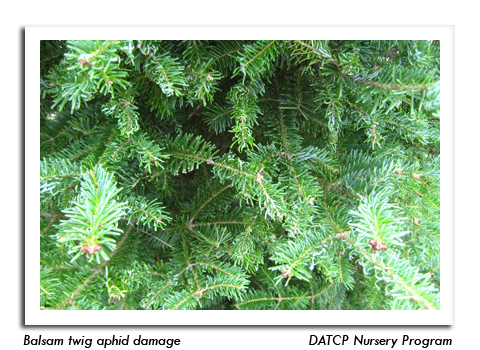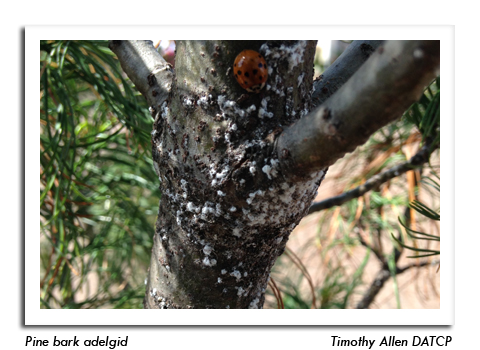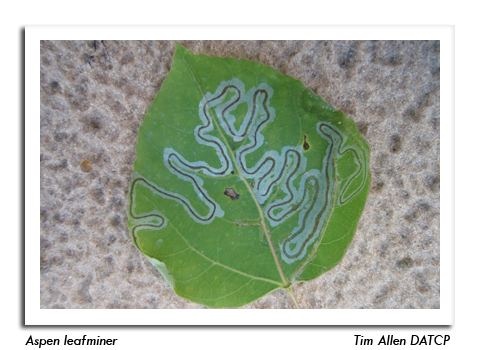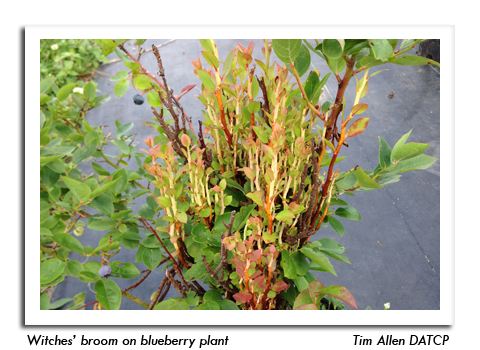
 |
|
|
Nursery & Forest
Volume 60 Number 19 Date 08/27/2015 BALSAM TWIG APHID - Balsam firs in Oneida County are showing twisted, distorted needles caused by this insect. Although light or moderate needle injury is usually inconsequential, aphid populations may build to damaging levels if left unchecked. Horticultural oils applied to the eggs in fall or spring, or insecticides directed against the immature stages in spring, can provide adequate control. SPRUCE NEEDLE RUST - Nursery inspectors report that this common rust disease is apparent on spruce trees in northern Wisconsin. The symptoms are orange, powdery spores that appear on the undersides of current-year needles. Spruce needle rust has two hosts, alternating from Labrador tea to spruce in spring, and from infected spruce to Labrador tea in summer. Infected needles turn yellow and drop by the end of the growing season. In most instances, this rust is an aesthetic problem and no control is needed. Removal of all alternate host plants within 1,000 feet will reduce disease on spruce, but is usually impractical. PINE BARK ADELGID - The white cottony egg masses laid by female adelgids were observed on the bark, branches and trunks of eastern white pine trees at a nursery in Oneida County. The infestation was not severe, but pine bark adelgids can coat the surface of pines, stunting tree growth. An additional concern can be blackened needles from sooty mold growth on aphid honeydew. Tree death is rare and usually impacts older trees. Smaller trees are generally not attacked. Dormant oils may be applied in fall or spring to kill the overwintering nymphs. NECTRIA CANKER - Maple trees in Oneida County are reported to be exhibiting the target-like cankers indicative of this fungal disease. Cankers that occur on twigs or small branches can be pruned out, but larger trunk cankers require trees to be removed and destroyed to prevent the spores from infecting surrounding trees. A follow-up fungicide application subsequent to pruning may help to protect wounds against infection. -- Ellen Natzke, DATCP Nursery Inspector ASPEN LEAFMINER - Serpentine leaf mines caused by the larval stages of this insect were evident on aspen leaves in Jackson and Marquette counties earlier this month. The mines are formed as larvae feed between the upper and lower leaf surfaces. While this leafminer rarely causes tree mortality, its mining can lead to reduced photosynthesis, disrupted stomatal function, reduced growth and premature leaf drop, especially when trees are already stressed by drought or other insects. Outbreaks have not been documented in Wisconsin, though aspen leafminer problems are common in Alaska and other parts of this insect's geographic range where silvery foliage is visible along highways in high-population years. WITCHES' BROOM ON BLUEBERRY - Blueberry plants in Oneida County were found to be infected with this rust fungus, which uses balsam fir as its alternate host. Diseased plants exhibit clumped, broom-like branches with stunted, discolored foliage. These 'brooms' later turn brown and eventually die. Individual brooms can be pruned out, but the fungus will persist in the plant indefinitely, creating future brooms until the plant is killed or destroyed. Heavily infected blueberry plants produce little or no fruit. Recommendations for healthy blueberry propagation include using rust resistant varieties and locating plants at least 500 yards from balsam fir trees if possible. -- Tim Allen, DATCP Nursery Inspector 



|
|
|